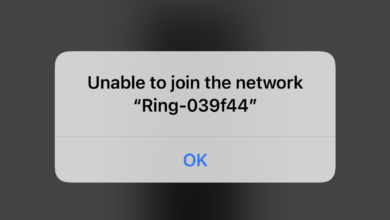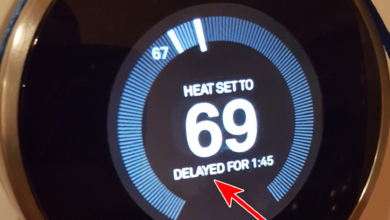How to Fix WiFi Not Connecting on Your Samsung TV?
Despite the convenience and advanced features of Samsung Smart TVs, users occasionally face challenges with WiFi connectivity. There have been increasing reports from individuals struggling to connect their televisions to their home wireless networks.
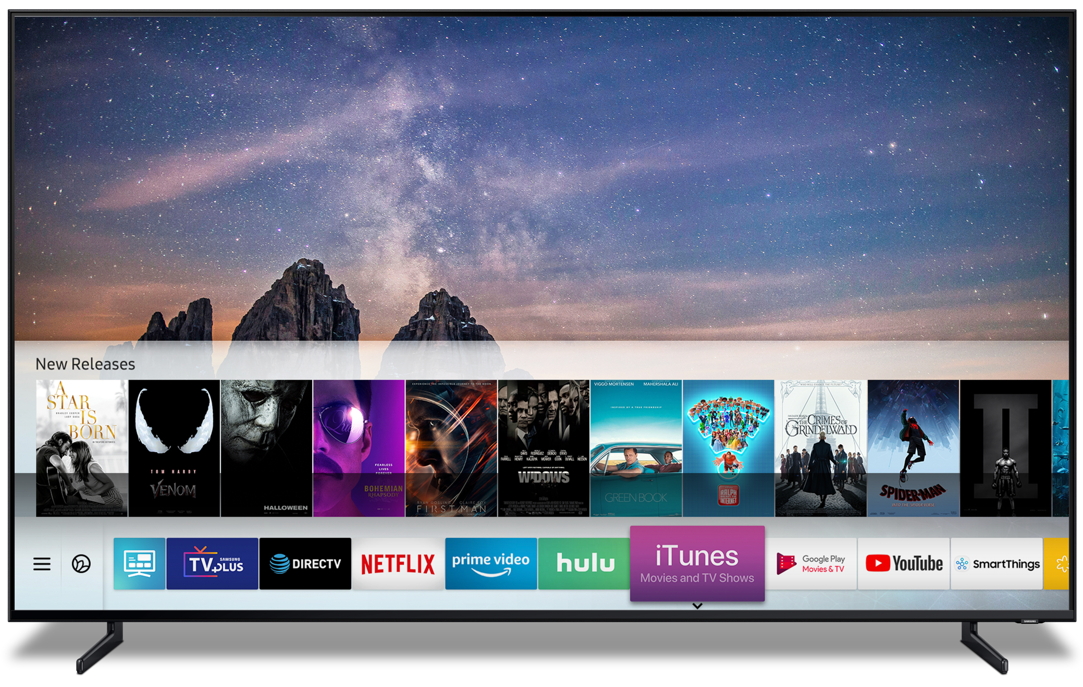
This article will provide a set of proven solutions to address this issue, along with possible reasons why the WiFi feature on the TV might be malfunctioning.
What Prevents Samsung Televisions from Connecting to WiFi?
Our investigation has revealed that there is no single cause for the problem, which can occur due to various reasons. Some of the most prominent causes include:
- Outdated Firmware: A televisions firmware that hasnt been updated to the latest version might not function correctly. The TV needs the newest firmware to make sure all settings are appropriately configured based on the region.
- General Bug: There have been reports of a common software bug in Samsung Smart TVs whereby, if the TV is turned off using the remote for longer than 10 to 15 minutes, network settings may become corrupted and require resetting to establish a proper connection.
- MAC Address Block: Each device connects to a WiFi router using a unique MAC address. Should this address be blocked—either by the user or the ISP—the TV will no longer connect to the WiFi network until the block is lifted.
- DNS Settings: Incorrect DNS settings on the TV can lead to conflicts with the router when attempting to connect to the internet. These settings may need to be manually adjusted by the user for the internet to function correctly.
Equipped with an understanding of why the problem occurs, we can now explore the solutions. Its recommended to follow these solutions in the order provided to prevent potential conflicts.
1. Restart the TV
Restarting your TV flushes the system memory and can resolve temporary software glitches that may be causing the Wi-Fi connectivity issues. By fully powering down the TV and unploting it for a short period, youre allowing all capacitors to discharge and all volatile memory to clear. This makes sure that when you turn the TV back on, it starts fresh, which can lead to restoring a stable connection to your WiFi network.
- Turn on the TV as you usually would and allow it to run for 5 minutes.
- Instead of using the remote, unplug the power cable directly from the wall socket.
- Wait for at least 20 minutes before powering the TV back on.
- Enter the WiFi password if prompted, and verify if the issue has been resolved.
2. Restart the Internet
The issue might lie with the internet connectivity or incorrect DNS settings of the router, preventing the TV from accessing the internet.
Restarting the internet can clear any glitches in the routers memory, refresh your connection to your Internet Service Provider (ISP), and resolve IP conflicts between your devices, which in turn could re-establish your TVs WiFi connection.
- Turn off the power supply to the internet router.
- Wait for at least 10 minutes before restoring power.
- Once the internet settings are loaded and access is granted, try connecting the TV to the WiFi and see if the problem persists.
3. Change the Internet Connection
By attempting to connect your TV to an alternative network, such as your smartphones mobile hotspot, you can discern if the original WiFi connection is the source of the problem. If the TV connects to the hotspot without issues, it implies that your usual WiFi network might be blocking the TV’s MAC address or facing other specific connectivity barriers that do not affect other devices.
This allows you to take the necessary steps, such a contacting with your ISP or adjusting router settings, to resolve the connectivity issue on your primary network.
- Turn on the TV and navigate to the WiFi settings.
- Enable the mobile hotspot feature on your smartphone.
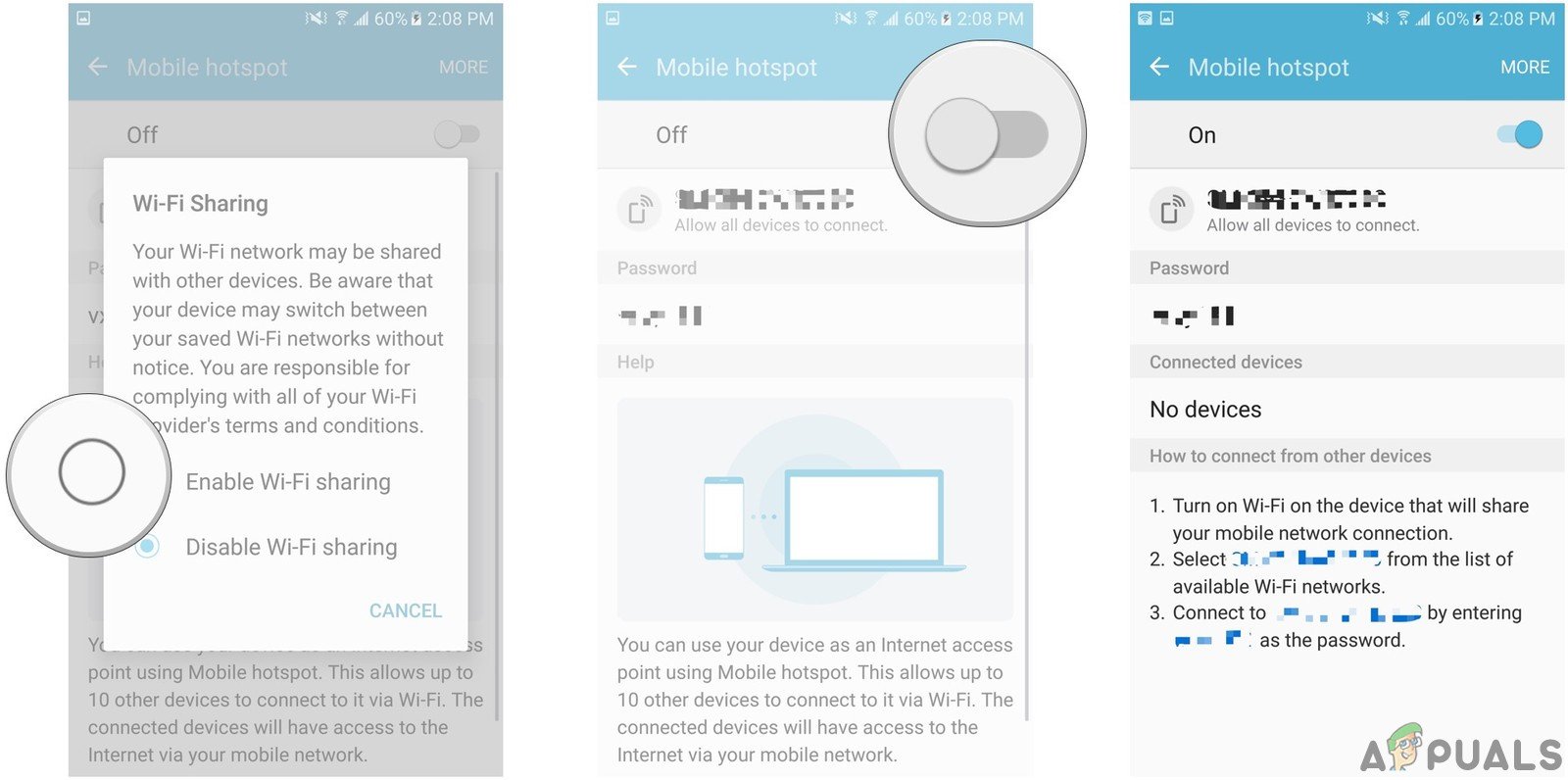
Turning on the Mobile Hotspot - Select the hotspot from the list of available connections, and check whether the TV can connect to it.
- If the TV connects to the mobile hotspot successfully, its likely that the TVs MAC address is blocked by the internet router.
- Contact your ISP to request they unblock the TVs MAC address.
4. Firmware Update
Bascially, the firmware is the software that looks over how your TV operates; its the critical code that controls everything from the menu interface to internet connectivity functions. By updating it, you make sure that any known bugs or glitches affecting WiFi performance are ironed out.
Manufacturers routinely release updates to enhance device compatibility with newer routers, improve security, and ensure optimal functionality. So, refreshing your TVs firmware can bridge communication gaps between your TV and home network, potentially restoring that smooth streaming experience youve been missing.
- Open this link and select the correct model for your Samsung TV.

Samsung Product Support Center - Initiate the download and wait for it to complete.
- Extract the downloaded files onto a USB drive that is free of other data.
- Ensure that your computer has not added any extra symbols or numbers to the downloaded files name.
- Insert the USB drive into the TV and press the Menu button on the remote control.
- From the menu, select Support, followed by Software Upgrade select By USB as the update method.
- If prompted, confirm the new update installation and wait for the process to complete.
- Afterward, try connecting to WiFi to see if the issue persists.
5. Refresh DNS Settings
DNS, which stands for Domain Name System, is similar to a phonebook for the internet, translating human-friendly domain names into IP addresses that computers use. If the DNS settings on your TV are incorrect or outdated, it may struggle to communicate effectively with your network router, leading to connectivity issues.
By refreshing these DNS settings and manually setting them to a reliable server like Googles public DNS (8.8.8.8), you realign your device with the internets directory service, potentially resolving any connection issues.
- Hit the Menu button on the remote, select the Settings option, then Network, and proceed to Network Settings.
- Choose DNS mode, make sure its set to Manual, and confirm with OK.
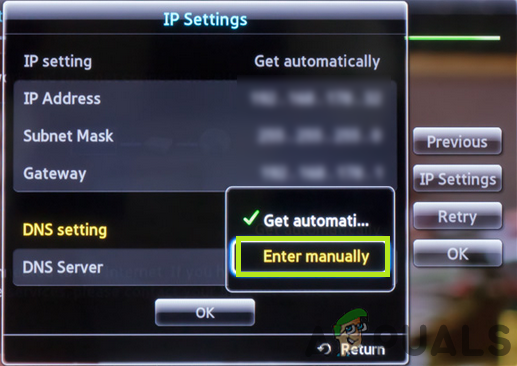
Navigating to the Enter Manually option and pressing OK - Type 8.8.8.8 for the DNS and press OK.
- This should restore internet access if the problem was DNS-related. Then, you can use the Samsung Smart Hub button to automatically update the television and reset outdated programs.
6. Perform a Hard Reboot
When you hard reboot your Samsung Smart TV, it acts as a system refresh, clearing temporary configurations that may have gone wrong. This process can potentially fix glitches that cause connectivity issues, giving your TV and its Wi-Fi functionality a fresh start. This turn it off and on again method is a timeworn troubleshooter for a reason—it often works wonders.
- Long-press the Power button on your Samsung TVs remote.
- Maintain the press until the TV reboots, releasing it once the Samsung logo appears.
- See if this rebooting method fixes the issue.
Note: If the problem persists after trying all the solutions, it may be a hardware issue rather than a software one. In that case, contact Samsung Customer Support.
Before attempting to fix the WiFi issue on your Samsung TV, make sure no accessory is connected to the TV (e.g., Firestick, Chromecast, Android Streaming Box, Soundbar, WiFi Extender, Xbox, Blu-ray, DVD player, etc.). It is also advisable to remove extra devices from the network (like network storage devices).
Furthermore, check if connecting the TV without a surge protector or to a power source in another room, or using a different power adapter, resolves the issue.
7. Edit the TV Settings
If the TV still experiences issues, incorrect configuration of the Samsung TV’s settings might be the cause—particularly if it fails to connect even to a phone hotspot. Users may find success with the following settings, though note that instructions may vary slightly between users.
Refresh Resources in the Smart Hub
- Open the Smart Hub on your TV and select Source.
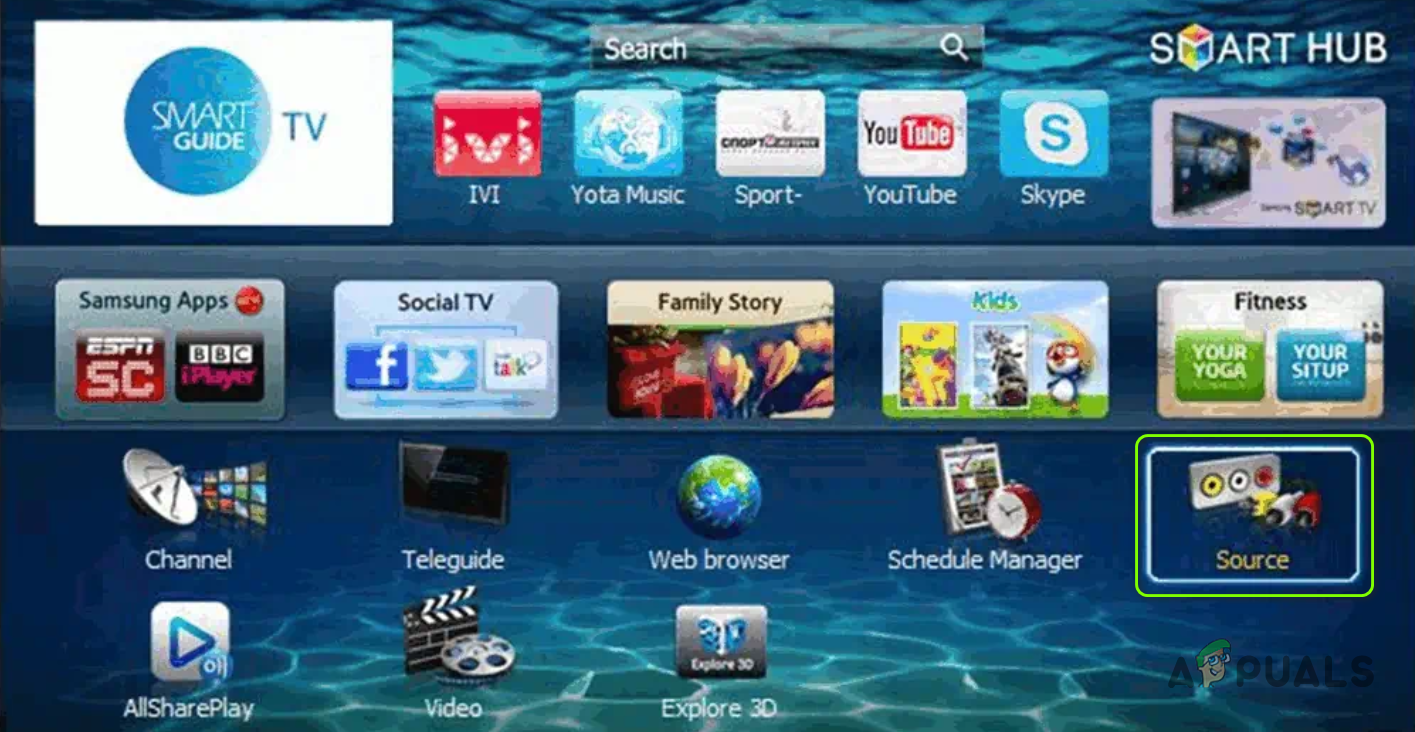
Open Source in the Smart Hub - Press the A button (typically red) to refresh sources, then attempt launching an app (e.g., Netflix, YouTube) to see if the issue is resolved.
Change the TV Name
- Access the TV Settings and navigate to the Network tab.
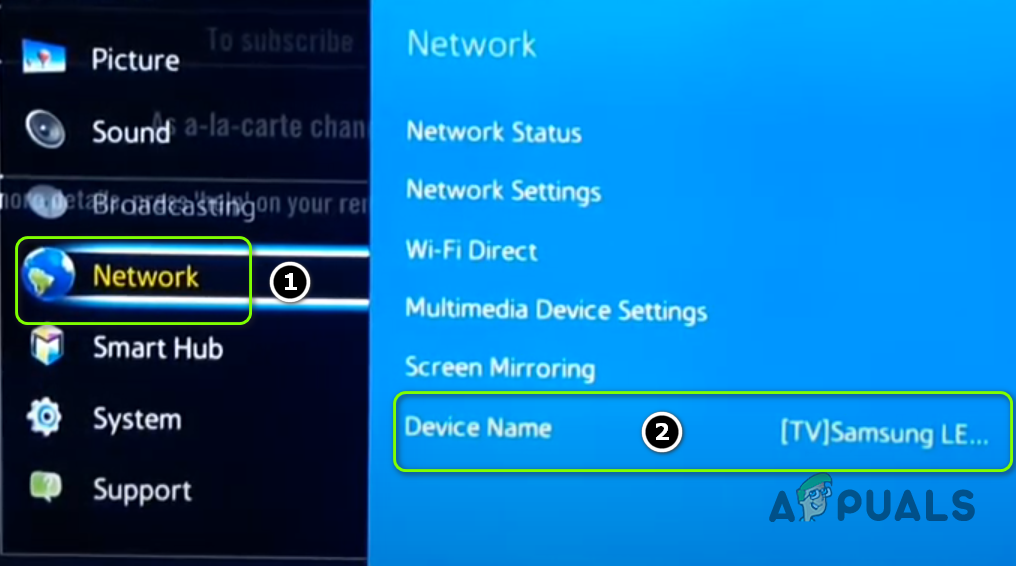
Change the Device Name of the Samsung TV - Select Device Name and type in a new name for the TV (ensuring it’s unique within the network).
- Restart your TV and verify if WiFi connectivity has been restored.
Reset Network Settings of the TV and Disable IPV6
- Enter the TVs Settings and select General.
- Choose Network followed by Reset Network Settings.
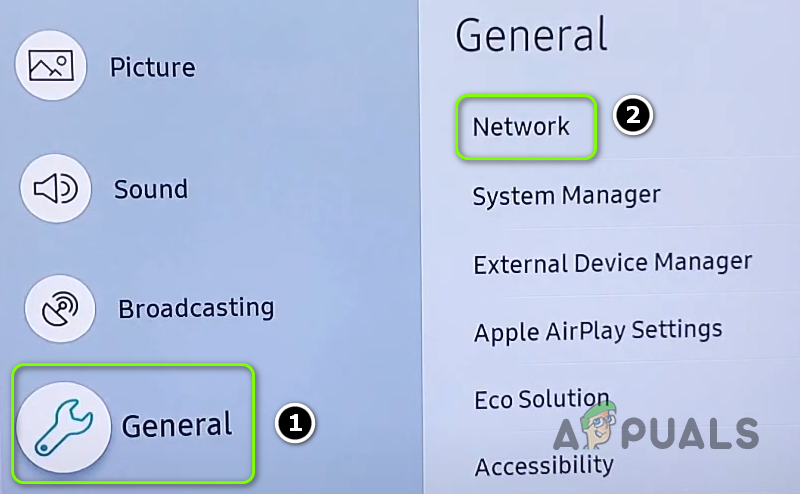
Open Network in General in the Samsung TV Settings - Confirm the reset and wait for its completion.
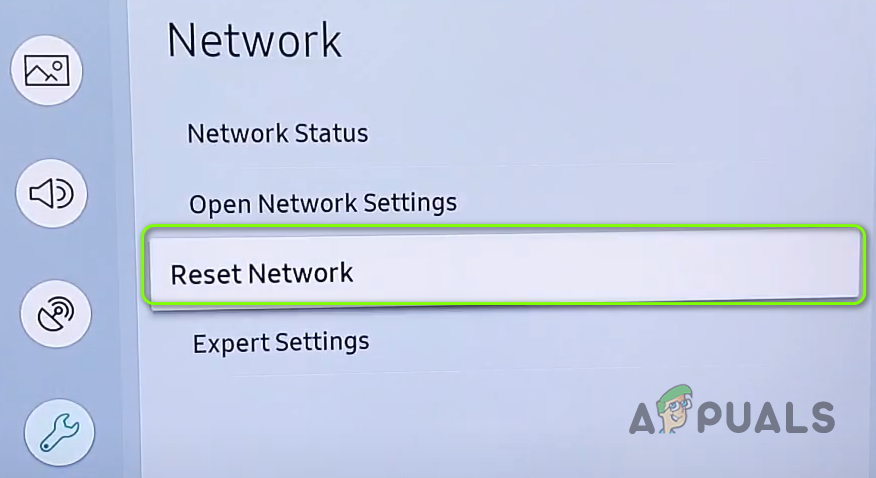
Reset Network Settings of the Samsung TV - Power the TV down, wait a minute, then power it back on and reconnect to the network in the Network Settings to see if the problem is fixed.
- If the issue continues, navigate to the Network Settings and check if disabling IPV6 (which may require accessing Expert Settings) solves the difficulty.
Disable Power On with Mobile
- Head to the Settings and then General.
- Choose Network and Expert Settings.
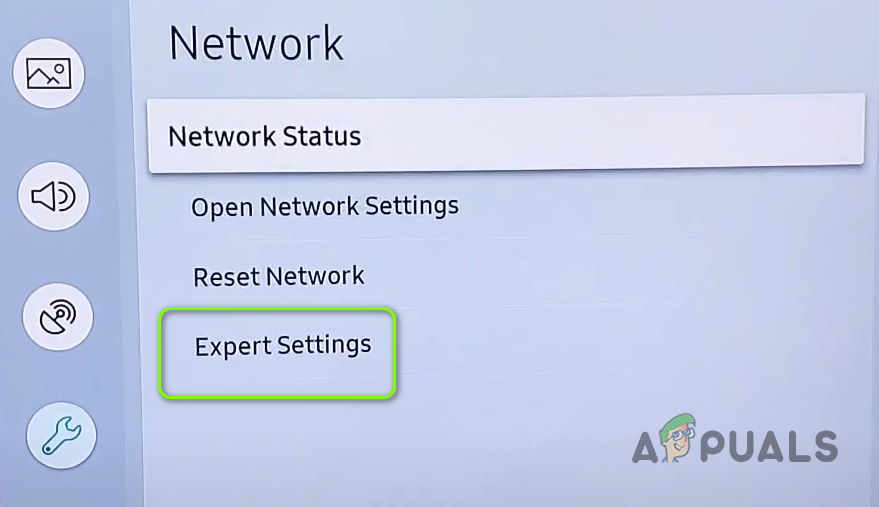
Open Expert Settings of Samsung TV - Select Power On With Mobile and disable the feature (this may block the operation of the SmartThings mobile app on the TV).
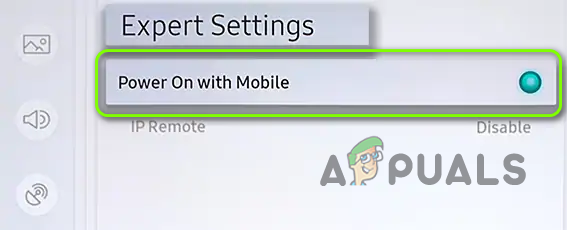
Disable Power On With Mobile - Reboot your TV and check if the Wi-Fi issue has been resolved.
Disable Samsung Instant On
- Press the Menu key on the remote and proceed to System.
- Scroll down, select General, followed by Samsung Instant On and disable it.
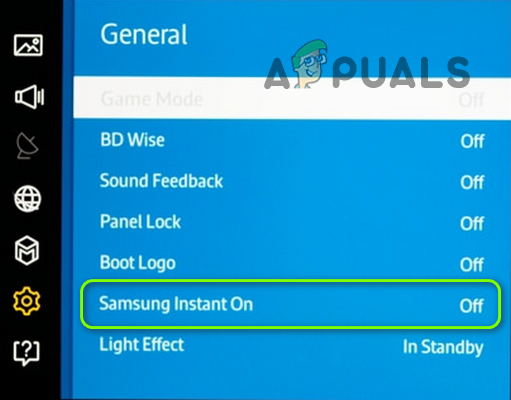
Disable Samsung Instant On - Restart your TV to see if the Wi-Fi issue is no longer present.
Set the Usage Mode to Home
- Go to Settings then General.
- Expand Usage Mode and input the default PIN (usually 0000), then select Home Mode.
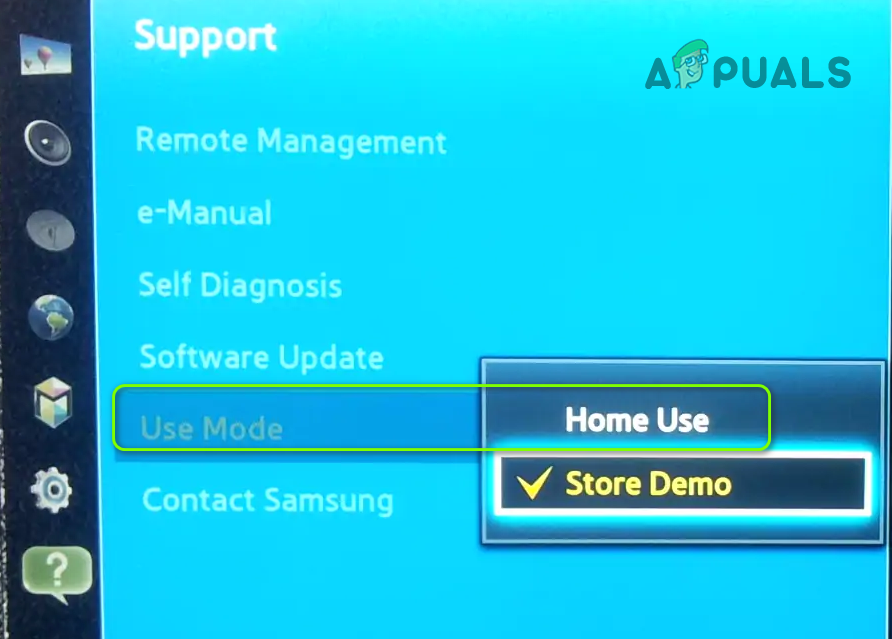
Change Samsung TV Use Mode to Home Use - Restart your TV and check if Wi-Fi functionality has been restored.
Disable Auto Launch Last App and Autorun Smart Hub
- Navigate to Settings then to General.
- Choose Smart Features and the Autorun Last App option, then disable it.
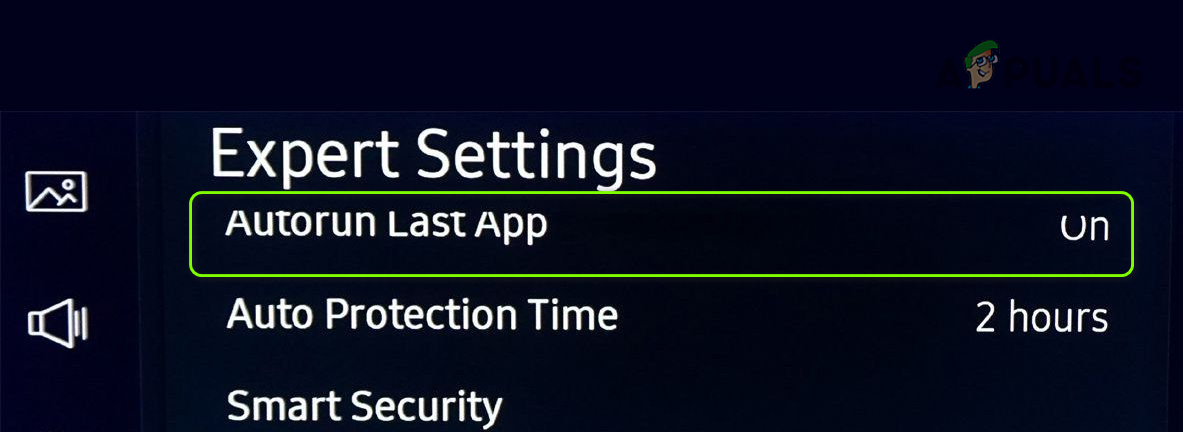
Disable Autorun Last App of the Samsung TV - Reboot your TV to determine if the Wi-Fi connection has been repaired.
- If the issue is ongoing, head back to Smart Features and turn off Autorun Smart Hub to see if the issue is fixed.
Disable the AnyNet+ Feature
- Enter your TVs Settings, choose General, then External Device Manager, followed by AnyNet+ and disable it (this action may impede the control of certain devices, such as Soundbars).
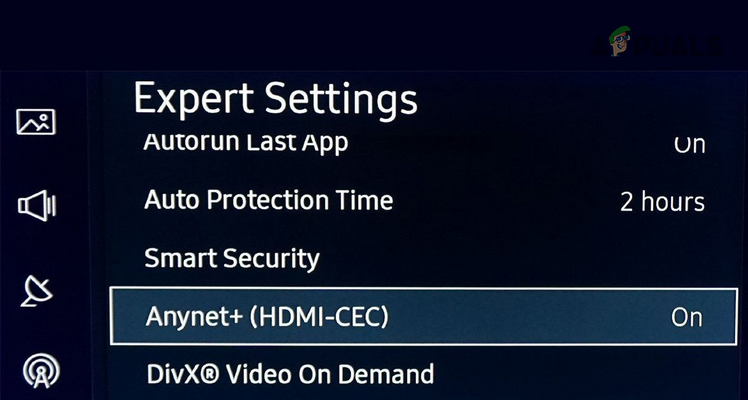
Disable Anynet+ - Restart your TV and assess if the Wi-Fi connectivity has improved.
Change the Time Zone of Your TV
- Proceed to the Settings, select General, then System Manager, followed by Time.
- Adjust the Time-Zone. If this option is unavailable, set the Clock to Auto.
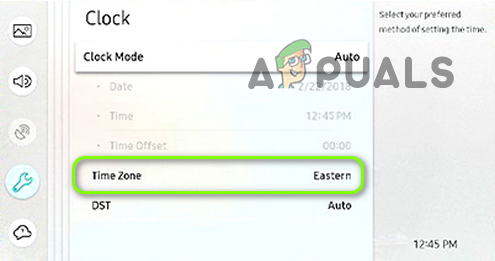
Change Time-Zone of Samsung TV - Reboot your TV and check for improvements in Wi-Fi connectivity.
Disable the Soft AP Option
- Open the Settings and navigate to the Network section, then switch off Soft AP.
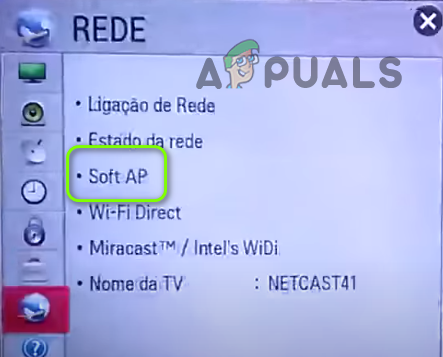
Disable Soft AP - Restart your TV and see if the Wi-Fi is functioning properly.
Manually Change the IP Address of Your TV
- Go to Settings, find the Network tab, and then select Network Status.
- Select IP Settings.
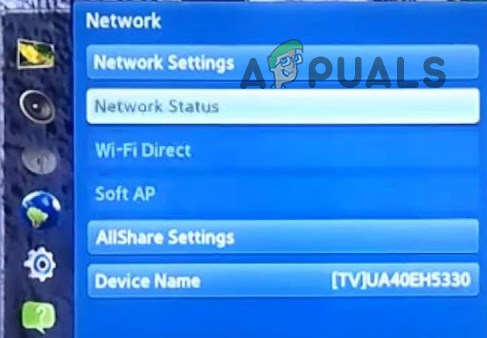
Open Network Status of Samsung TV - Change the IP settings to Manual (record the current settings before proceeding) and input the appropriate IP information. Note that you should make sure to enter the correct gateway. This is particularly crucial if youre using a tri-band Wi-Fi router.
- Enter the DNS information as discussed in Solution 5 or per any other device on your network and verify if the issue is now fixed.
- If not, consider using one of the following DNS settings to see if the issue is resolved:
4.2.2.1 208.67.222.222
Reset the Smart Hub of Your TV to Defaults
- Access the TVs Settings and select Support.
- Choose Self Diagnosis and then Reset Smart Hub (take note that this may erase certain configurations such as accounts and passwords). Enter your PIN (in most cases, the default is 0000).
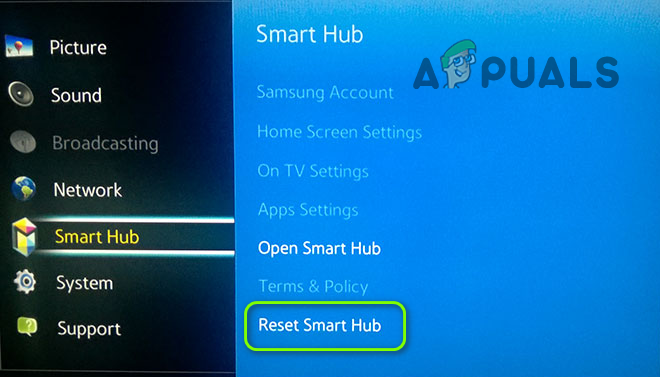
Reset Smart Hub - Wait for the reset process to conclude and then check if the Wi-Fi issue is resolved.
Change the Country of Your TV
- In your TVs Smart Hub, press the sequence of keys “>> (fast forward), 2, 8, 9, << (rewind)” on your remote.
- Change the country setting to another one (for instance, USA or Australia) and agree to the Samsung terms and conditions if prompted.
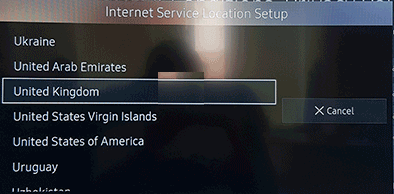
Change Country in the Service Mode of Samsung TV - Ascertain whether the Wi-Fi issue is fixed. If so, then try reverting back to your original country to see if the Wi-Fi still works.
Change the Wi-Fi Region and Perform an SVC Reset
- Power off your TV and access the Service Mode (exercise caution as incorrect changes here can permanently damage your TV). You may need to press the sequence on your remote:
Info >> Menu >> Mute >> Power
- Navigate to Control >> Sub-Option and switch the Wi-Fi Region to A.
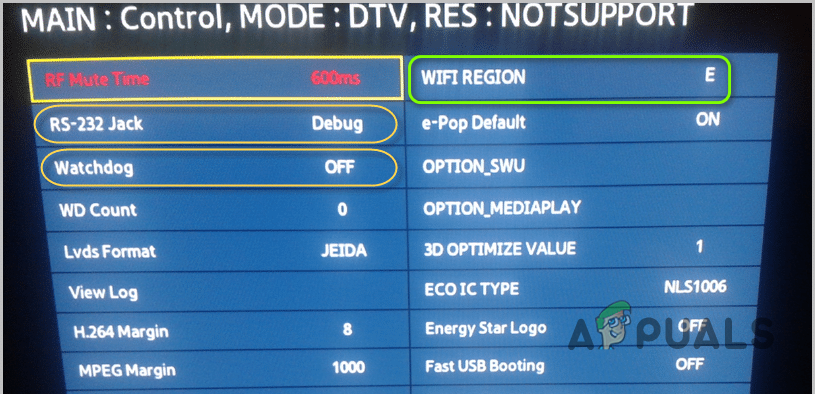
Change the Wi-Fi Region in the Service Mode - Apply the changes and reboot your TV.
- Following reboot, verify if the Wi-Fi is operational.
- If the problem persists, enter Service Mode again and select SVC.
- Choose SVC Reset and allow the TV to restart.
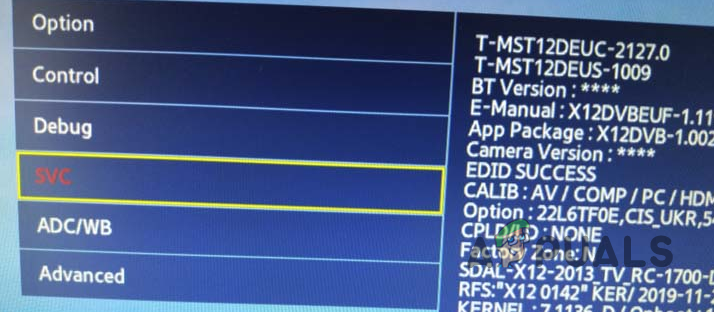
Reset SVC in Service Mode - Once restarted, reconfigure your TV if required, and determine if the Wi-Fi functions correctly.
If these steps do not resolve the issue, a Factory Reset of Your TV may be necessary.
Sign in to the Samsung Account
- Navigate to your TVs Settings and head over to the Smart Hub section.
- Select Samsung Account and sign in. If youre already signed in, re-enter your credentials.
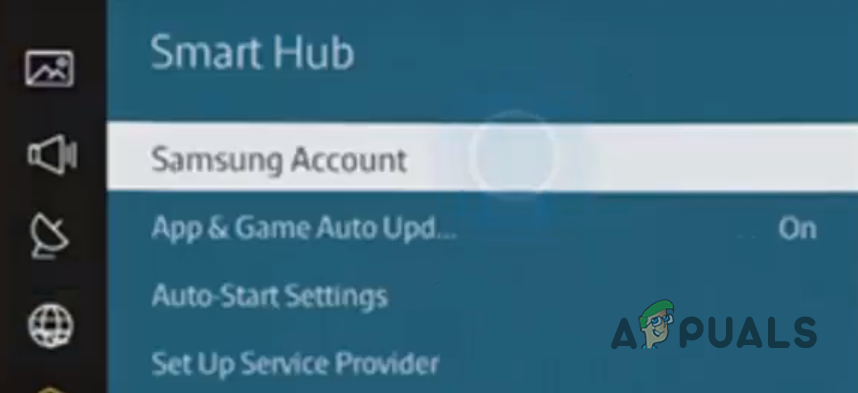
Open Samsung Account in the Smart Hub - Afterward, restart your TV and check if the Wi-Fi issue has been fixed.
8. Edit the Router Settings
If your TV connects properly using a mobile hotspot, then the issue is likely due to incorrect router configuration. Consider adjusting the following settings, which have helped other users resolve similar issues:
- Make sure that your routers firmware is up-to-date and check if that solves the problem.
- Disable features such as Nvidia Shield or PiHole to ensure they arent blocking Wi-Fi access.
- Verify that the MAC address of the Samsung TV is not blocked by any parental control or ISP management applications. Also, confirm that the router’s MAC filtering isn’t the root cause. Adding the TV to the Trusted Devices list in the router settings may fix the problem.
- If your router is dual-band (2.4 GHz and 5 GHz), try disabling one of the bands or assigning different names to each. This can be especially helpful if you disable the 5 GHz band or use a different SSID for each.
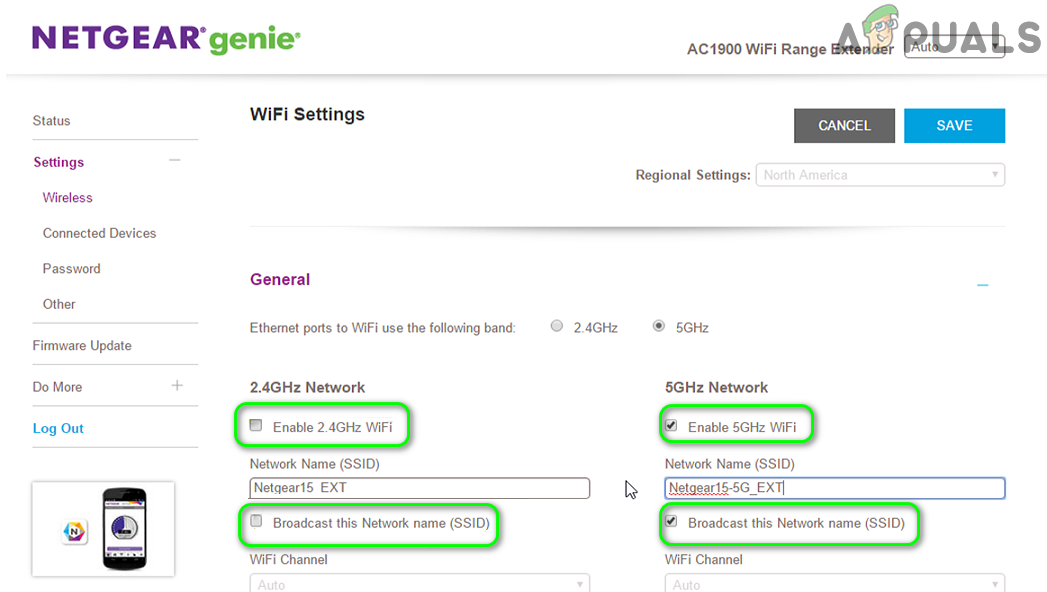
Disable 5GHz Band in the Routers Settings - Choose a Wi-Fi channel that is less crowded, as determined by a Wi-Fi channel scan app, switching to a different channel, such as 11, if necessary. Also, make sure Automatic Channel Switching is turned off. If using a 5 GHz band, ensure it’s a non-DFS channel.
- Try changing the wireless mode to Legacy, G, N, or Auto to determine if that resolves the connectivity issue.
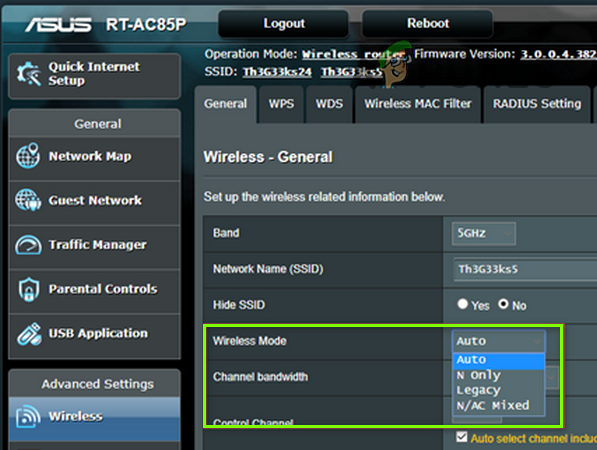
Change Wireless Mode to Legacy - Confirm that IPV6 is disabled in the routers settings.
- Enable UPNP in the router settings and observe whether that solves the issue.
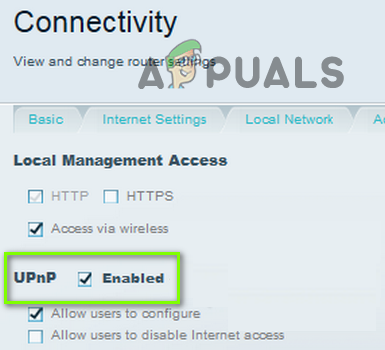
Enable UPnP - Check for a built-in firewall in your router and consider disabling it (at your own risk due to potential security vulnerabilities) to see if that was the culprit. If so, properly configure exceptions for the TV within firewall settings.
- If utilizing a hidden SSID, reveal it and observe whether this resolves the problem. Additionally, renaming Wi-Fi might help.
- Assess if your router has Smart Wi-Fi/Smart Connect/Smart Assistant features, and if so, either enabling or disabling them might fix the issue.
- Disable the Auto-Optimize Network/Channel Optimization feature in your routers settings and check if the issue is resolved.
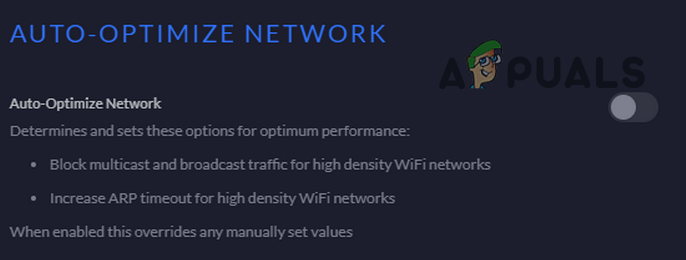
Disable Auto-Optimize Network - Turn off the Connect High-Performance Devices to 5 GHz Only feature in your routers settings.
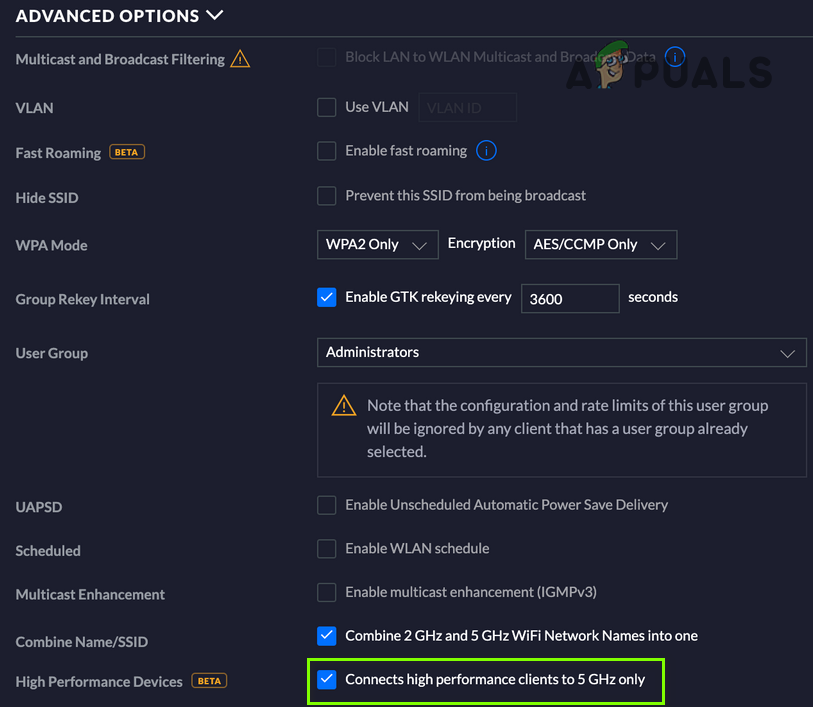
Disable High Performances Devices - Check if turning off the Uplink Connectivity Monitor addresses the Wi-Fi trouble.
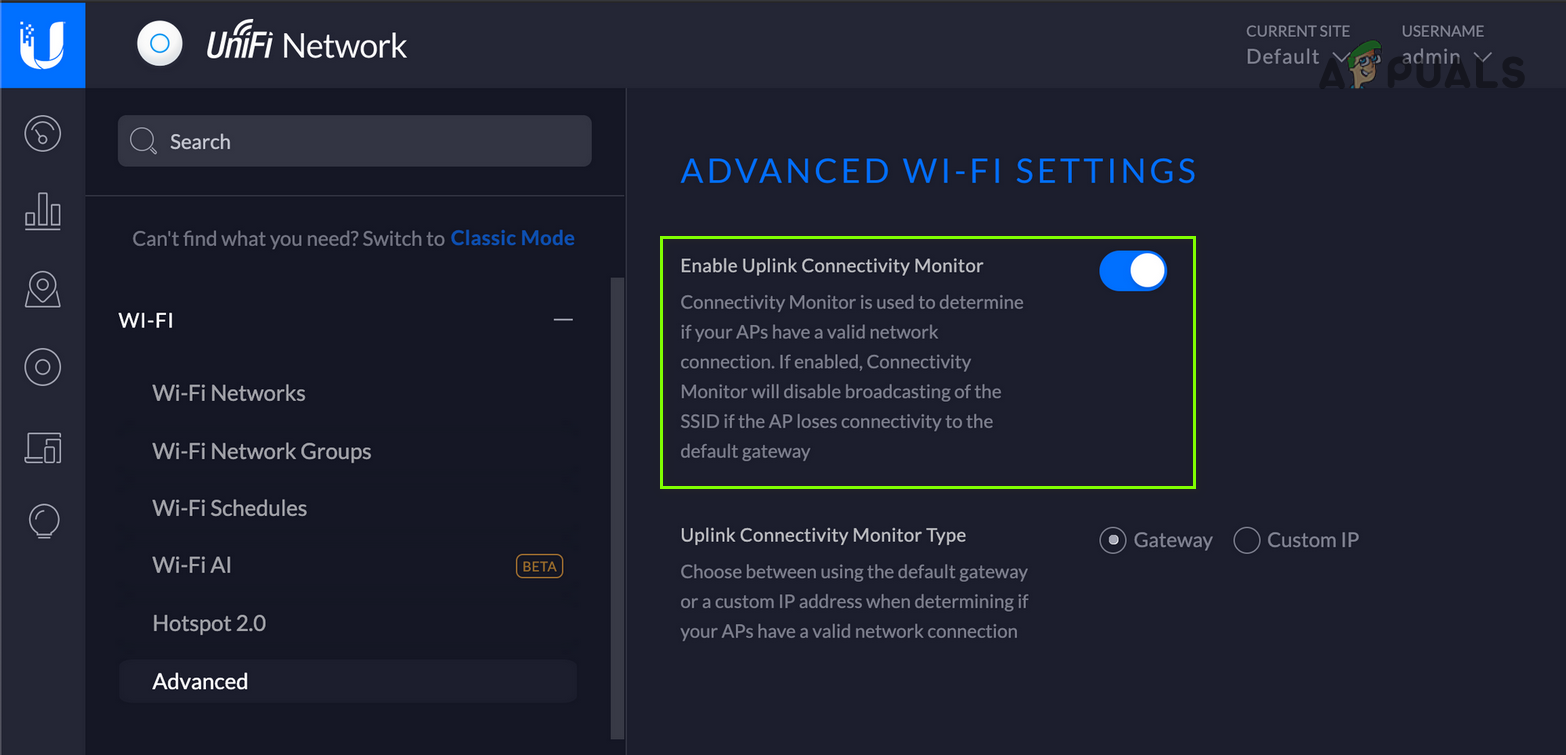
Disable Uplink Connectivity Monitor - If roaming is an issue, disabling the Roaming Assistant may help resolve the matter.
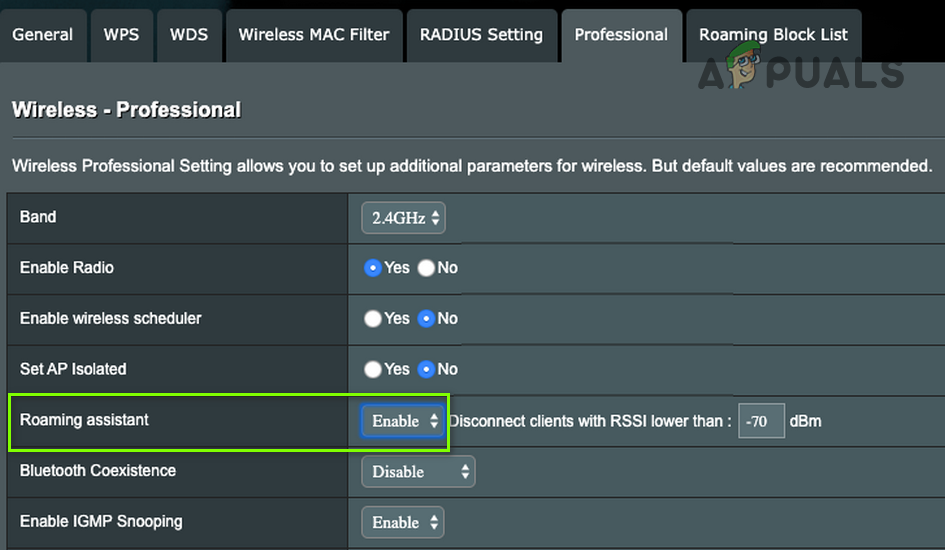
Disable Roaming Assistant - Deactivate Packet Filtering and check if the Wi-Fi problem has been fixed.
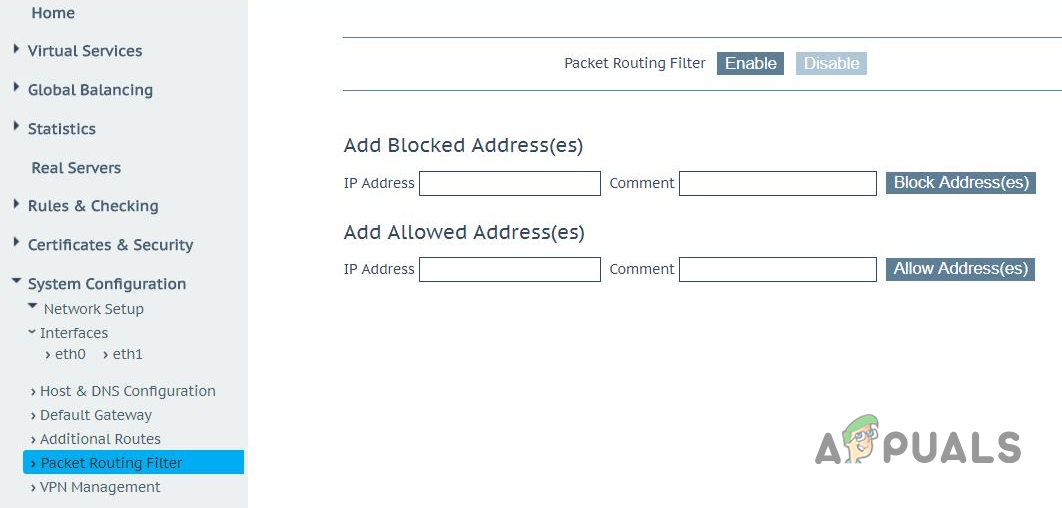
Disable Packet Filtering - Make sure that your routers WPS feature is enabled, and then use it to see if it helps connect your TV to Wi-Fi.
- Try toggling your Wi-Fi routers encryption between WPA/WPA2 or WPA3 to see if that resolves the issue. If unsuccessful, see if setting the encryption to TKIP works.
- If none of the aforementioned methods are effective, consider adjusting the DHCP settings of your router, such as assigning a fixed IP lease to the TV.
- Check whether setting up a Guest network and connecting only the Samsung TV to it addresses the Wi-Fi problems.
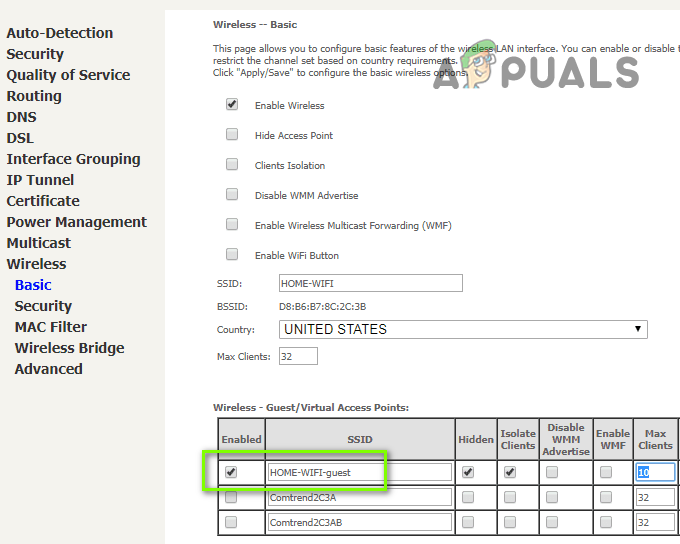
Create Guest Wi-Fi Network - If the problem remains unsolved, a factory reset of your router might clear up the issue. If that still doesnt work, consider using a different router or an extender, especially if your TV can access the internet via your mobile phones hotspot.
Should the issue still persist, consider using an Ethernet cable to connect to the internet, or have the TV inspected for hardware problems. In some cases, as reported by a few users, replacing the Wi-Fi module fixes the problem, although in rare situations, the mainboard of the TV may need to be replaced.




